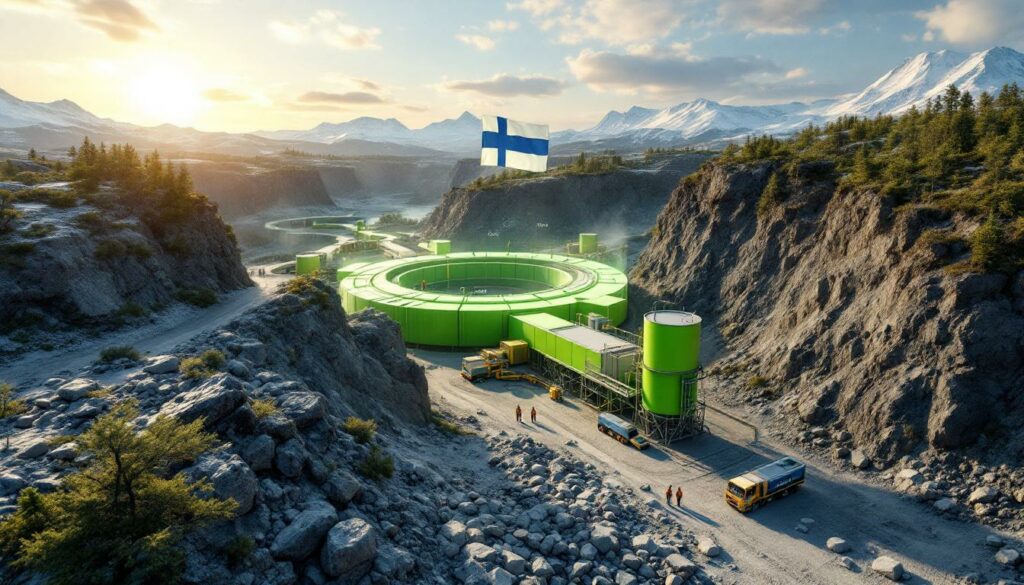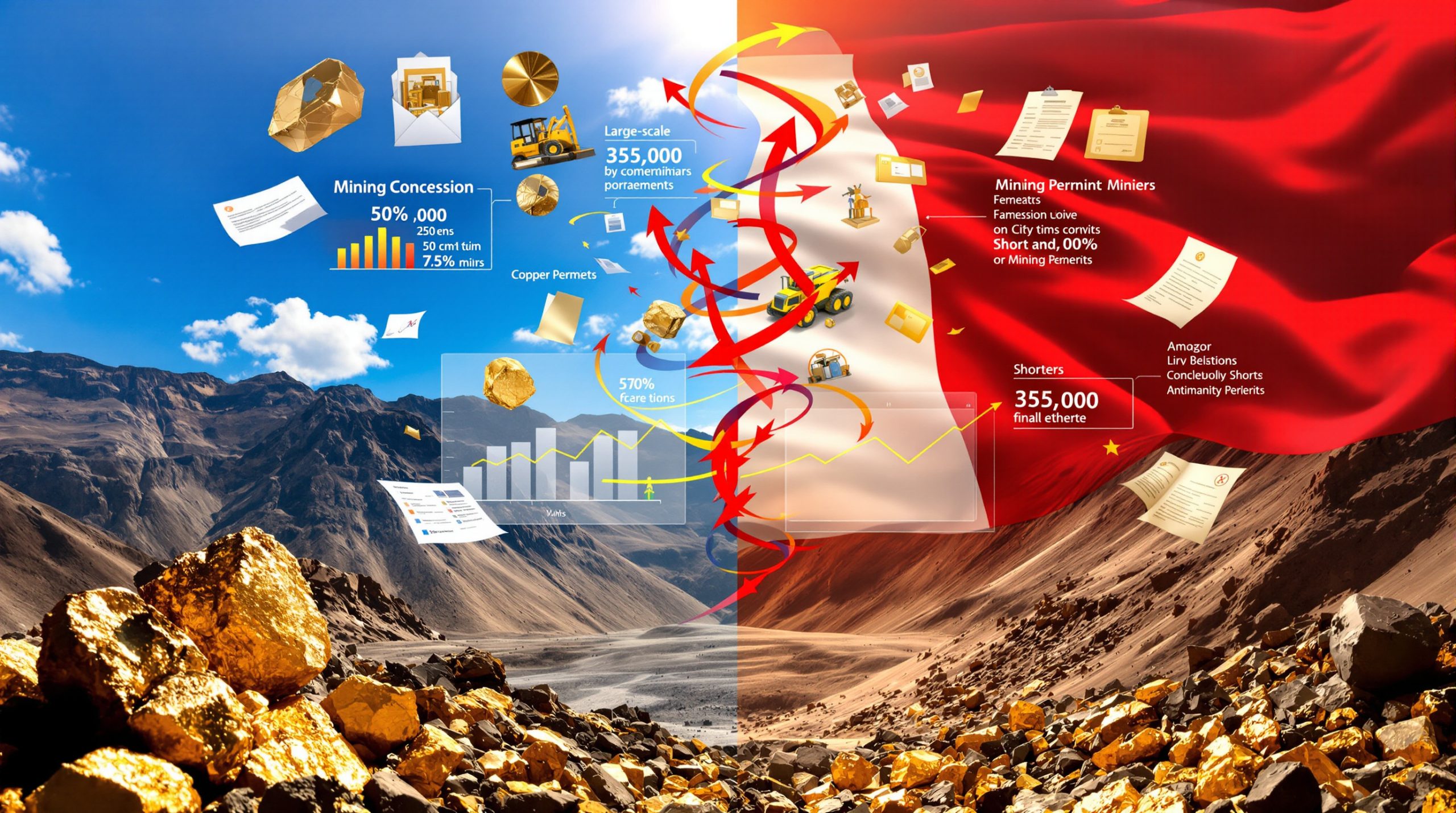What is the Betolar-Anglo American Collaboration About?
The Betolar-Anglo American partnership represents a groundbreaking approach to sustainable mining operations, centered on innovative waste management and circular economy principles. This strategic collaboration focuses on implementing advanced metal extraction technology and green cement production at the Sakatti Cu-Ni-multimetallic project located in Sodankylä, Finland.
The partnership establishes a framework for transforming what would traditionally become mining waste into valuable resources through a dual-purpose approach. By processing the same waste stream for both metal recovery and cement production, the collaboration aims to dramatically reduce the environmental footprint of mining operations while creating additional value streams.
Tuija Kalpala, President and CEO of Betolar, explains the core technology:
"Our metal extraction technology enables both the efficient recovery of valuable metals and the production of low-carbon green cement – all from the same waste material stream. We are pleased to support Sakatti mine's goal of minimising mineral waste."
The commercial agreement between the companies prioritizes resource efficiency, waste reduction, and carbon footprint minimization—three critical challenges facing the modern mining industry innovation trends.
The Strategic Partnership Framework
At its foundation, this collaboration integrates Betolar's proprietary metal extraction and cement production technologies directly into Anglo American's operational planning for the Sakatti project. Rather than treating waste management as an afterthought, this partnership embeds circular principles from the earliest design stages of the mine.
The project specifically targets the production of specialized green cement for tailings paste backfill—a crucial component in responsible mine management that returns processed waste material to mined-out areas underground. This practice significantly reduces surface storage requirements for mine tailings while improving structural stability of underground operations.
By developing on-site cement production capabilities from materials that would otherwise be classified as waste, the Sakatti project aims to establish a new benchmark for resource efficiency in mining. This approach eliminates the need to transport commercial cement to remote mining locations, further reducing the operation's carbon footprint.
Key Objectives of the Collaboration
The partnership between Betolar and Anglo American encompasses several ambitious objectives that extend beyond conventional mining sustainability transformation:
- Integrated waste valorization: Converting mining by-products into valuable resources through metal recovery and cement production
- Carbon footprint reduction: Minimizing emissions through local processing and elimination of cement transportation
- Operational cost optimization: Creating value from materials previously considered waste while reducing disposal costs
- Technical innovation: Developing and testing next-generation mining technologies
- Industry leadership: Establishing a replicable model for sustainable mining operations
Pertti Lamberg, CEO of Anglo American in Finland, outlines the broader vision:
"Anglo American is designing and developing Sakatti as one of our next generation of FutureSmart mines – a low-carbon underground operation with minimal surface footprint. At the heart of this approach is our commitment to protecting the environment and embedding circular practices where possible, working with our partners to harness innovative solutions which reduce waste, while finding opportunity to transform any remaining material into potentially valuable resources."
The collaboration represents a significant shift from traditional mining practices, where waste management is often treated as a regulatory compliance issue rather than an opportunity for innovation and value creation.
How Does Betolar's Technology Transform Mining Waste?
Betolar's technology introduces a paradigm shift in mining waste management through its innovative dual-purpose approach. Unlike conventional processes that treat mining waste as a disposal problem, this technology creates two distinct value streams from materials that would otherwise be considered worthless or even problematic.
The Innovative Metal Extraction Process
The core innovation lies in Betolar's ability to extract valuable metals and minerals from mining waste streams while simultaneously preparing the remaining material for cement production. This sequential processing approach maximizes resource recovery while minimizing overall waste volume.
The technology employs a proprietary extraction methodology that targets specific metal compounds within mining waste. While the exact process remains confidential, industry experts suggest it likely involves a combination of physical separation, chemical processing, and specialized binding techniques that allow for the recovery of metals that would be uneconomical to extract through conventional means.
What makes this approach particularly valuable is its adaptability to various types of mining waste. The technology can be calibrated to process different mineral compositions, making it applicable across various mining operations and waste streams. This flexibility represents a significant advancement over traditional waste management approaches that are often highly specialized for specific waste types.
The economic benefits extend beyond simple waste reduction:
- Resource recovery: Extraction of valuable metals creates additional revenue streams
- Processing efficiency: Single-stream processing reduces handling and operational costs
- Waste volume reduction: Less material requiring long-term storage or disposal
- Regulatory compliance: Meets or exceeds environmental management requirements
- Value-added products: Creates marketable materials from waste streams
According to mining waste management experts, technologies like Betolar's could potentially recover between 15-25% of valuable metals from waste streams that would otherwise be uneconomical to process using traditional methods. This represents a significant opportunity for mining companies to enhance resource efficiency while reducing environmental impact.
Environmental Benefits of the Technology
The environmental advantages of Betolar's technology extend well beyond simple waste reduction. The integrated approach delivers multiple ecological benefits throughout the mining lifecycle:
-
Carbon emissions reduction: Green cement production generates significantly lower CO₂ emissions compared to traditional Portland cement manufacturing, which typically produces approximately 0.9 tons of CO₂ per ton of cement. Industry benchmarks suggest similar technologies can achieve 40-60% reductions in cement-related carbon emissions.
-
Circular material flow: By converting waste into usable products, the technology creates a closed-loop system that minimizes resource consumption and waste production.
-
Reduced land disturbance: Less waste requiring surface storage means smaller tailings facilities and reduced land disturbance footprint.
-
Water conservation: Integrated processing can reduce water usage compared to traditional waste management approaches.
-
Energy efficiency: On-site processing eliminates transportation requirements for both waste disposal and cement procurement.
The environmental impact of mining waste is substantial—traditional operations can generate up to 20-25 tons of waste per ton of metal produced. Betolar's technology directly addresses this challenge by transforming what would be waste into valuable resources, substantially reducing the environmental footprint of mining operations.
"The technology helps reduce waste overall and aims to lower costs while creating profitable waste management processes," explains Tuija Kalpala of Betolar, highlighting the dual economic and environmental benefits of the approach.
The cement industry alone accounts for approximately 8% of global CO₂ emissions, making innovations in this space particularly valuable for sustainability efforts. By producing low-carbon cement alternatives from mining waste, Betolar's technology addresses emissions challenges in both the mining and construction sectors simultaneously.
Why is Green Cement Production Revolutionary for Mining?
The integration of green cement production into mining operations represents a revolutionary development that transforms traditional waste management paradigms. This innovation addresses multiple industry challenges simultaneously while creating new opportunities for sustainable mining practices.
Superior Performance Characteristics
What truly sets Betolar's green cement apart is its exceptional performance characteristics compared to traditional alternatives. According to technical evaluations from Betolar, the cement produced through their process demonstrates binding qualities that not only match but potentially exceed those of conventional cement products.
Tuija Kalpala of Betolar notes:
"The green cement produced by our technology not only matches but can even surpass the performance of traditional cements. Therefore, quality will not be a barrier to the adoption of circular economy solutions."
This performance advantage is particularly evident when compared to ground-granulated blast furnace slag (GGBFS), a common cement substitute in mining applications. Industry standard GGBFS typically achieves compressive strength ranges of 50-70 MPa, while early testing of Betolar's cement indicates potentially superior strength development, especially in the critical early curing phases.
The technical advantages include:
- Enhanced early strength development: Critical for underground support applications
- Superior durability: Resistance to chemical degradation in mining environments
- Consistent performance: Reliable engineering properties for structural applications
- Application-specific formulation: Optimized for mining backfill requirements
- Environmental resilience: Performance stability in variable underground conditions
These performance characteristics are particularly valuable for tailings paste backfill applications, where strength development and durability directly impact mine safety and stability. By exceeding the performance of traditional cement alternatives, Betolar's green cement removes a significant barrier to circular economy adoption in mining operations.
Economic and Operational Advantages
Beyond environmental benefits, the economic case for green cement production in mining operations is compelling. The approach creates multiple efficiency gains and cost advantages throughout the mining lifecycle:
-
Integrated resource utilization: By using the mine's own waste streams as raw materials, operations eliminate procurement costs for external cement—a significant expense in remote mining locations.
-
Reduced transportation costs: On-site cement production eliminates the need to transport commercial cement products to often remote mining locations, reducing both costs and associated carbon emissions.
-
Minimized waste management expenses: By converting waste into valuable products, operations reduce or eliminate costs associated with waste storage, monitoring, and long-term liability.
-
Regulatory compliance efficiency: Proactive waste reduction helps operations meet increasingly stringent environmental regulations, potentially avoiding future compliance costs.
-
Value creation from waste: The dual recovery of metals and cement production transforms waste management from a cost center to a potential profit center.
The financial impact of these advantages can be substantial. Mining operations typically spend between 15-20% of operational expenses on waste management and environmental compliance. By transforming these costs into potential revenue streams, the technology creates significant operational advantages.
For mining companies operating in remote locations, cement transportation alone can increase costs by 30-50% compared to urban applications. On-site production eliminates these expenses while reducing associated carbon emissions from transportation.
Industry analysts suggest that integrated waste-to-cement operations could potentially reduce overall waste management costs by 25-40% while creating new revenue streams from previously discarded materials. This economic case, combined with superior technical performance, makes green cement production a truly revolutionary development for sustainable mining operations.
What Makes the Sakatti Project a Next-Generation Mine?
The Sakatti Cu-Ni-multimetallic project in Finland exemplifies Anglo American's vision for the future of mining—combining technological innovation, environmental stewardship, and circular economy principles to create a truly next-generation operation.
Anglo American's FutureSmart Mining Approach
At the heart of the Sakatti project is Anglo American's FutureSmart Mining™ framework—a comprehensive approach to sustainable mining that integrates cutting-edge technologies with responsible resource management. This framework encompasses several key design principles:
-
Underground-focused operations: By emphasizing underground mining methods rather than open-pit approaches, the project minimizes surface disturbance and visible environmental impact.
-
Carbon-reduction technologies: Integration of renewable energy, electrification in mining, and energy efficiency measures to minimize the operation's carbon footprint.
-
Water conservation: Advanced water management systems that minimize consumption and maximize recycling throughout the operation.
-
Biodiversity protection: Comprehensive environmental management plans to protect and enhance the surrounding ecosystem.
-
Community engagement: Collaborative approaches to ensure local communities benefit from the operation while minimizing negative impacts.
Pertti Lamberg, CEO of Anglo American in Finland, emphasizes this holistic approach:
"Anglo American is designing and developing Sakatti as one of our next generation of FutureSmart mines – a low-carbon underground operation with minimal surface footprint."
What distinguishes the Sakatti project from conventional mining operations is its integration of sustainability into core operational planning rather than treating it as an add-on compliance requirement. By embedding advanced technologies and circular principles from the initial design phase, the project establishes new benchmarks for responsible resource development.
Industry experts note that FutureSmart mines typically target 30% reductions in water use, 30% improvements in energy efficiency, and significant reductions in surface disturbance compared to conventional operations. While specific targets for the Sakatti project have not been publicly disclosed, the operation likely aims to meet or exceed these industry benchmarks.
Circular Economy Implementation
The Sakatti project's implementation of circular economy principles represents a fundamental shift in mining operational philosophy. Rather than following the traditional linear model of resource extraction, processing, and waste disposal, the operation embraces a circular approach where materials continuously cycle through the value chain.
Key circular economy elements in the Sakatti project include:
- Waste valorization: Converting mining by-products into valuable resources through Betolar's technology
- Closed-loop water systems: Minimizing fresh water intake through recycling and reuse
- Energy recovery: Capturing and utilizing waste heat and other energy sources
- Materials optimization: Designing for durability, repairability, and eventual recycling of equipment
- Ecosystem regeneration: Rehabilitating disturbed areas to support biodiversity and ecosystem services
This approach aligns with global sustainability trends while creating tangible operational benefits. By embedding circular practices throughout the mining lifecycle, the Sakatti project demonstrates how resource extraction can operate within planetary boundaries while maintaining economic viability.
The collaboration with Betolar serves as a cornerstone of this circular approach, transforming what would traditionally be considered waste into valuable resources. This partnership-based innovation model—leveraging specialized expertise from technology providers—represents a key strategy for accelerating sustainability in the mining sector.
While traditional mines might target 60-70% resource recovery with significant waste generation, next-generation operations like Sakatti aim to push recovery rates above 85% while dramatically reducing waste volumes. This represents a fundamental improvement in resource efficiency while minimizing environmental impact.
How Will This Collaboration Impact the Mining Industry?
The Betolar-Anglo American collaboration has implications that extend well beyond a single mining operation. By demonstrating the technical and commercial viability of integrated waste-to-resource technologies, this partnership could catalyze industry-wide transformation toward more sustainable practices.
Setting New Sustainability Standards
This collaboration establishes new benchmarks for responsible mining in several key areas:
-
Practical circular economy implementation: By demonstrating real-world application of circular principles in a commercial mining operation, the partnership moves circular economy from concept to practice.
-
Integrated waste management: The approach shows how waste management can be transformed from a cost center to a value creation opportunity through innovative technologies.
-
Carbon reduction pathways: The project provides a concrete example of how mining operations can significantly reduce their carbon footprint through innovative approaches to material processing.
-
Commercial viability: Perhaps most importantly, the collaboration demonstrates that sustainable practices can be economically viable, addressing one of the primary barriers to industry-wide adoption.
-
Partnership innovation models: The collaboration showcases how specialized expertise from technology providers can accelerate sustainability innovation in mining.
Mining industry analysts suggest that successful demonstrations like the Sakatti project could accelerate industry-wide adoption of similar technologies, potentially reducing the sector's overall waste generation by 15-25% within a decade. This represents a significant advance toward more sustainable resource extraction practices.
The collaboration also addresses growing regulatory and investor pressure for improved sustainability performance in the mining sector. With frameworks like the EU Taxonomy and rising ESG expectations from investors, mining companies face increasing scrutiny of their environmental practices. Initiatives like the Betolar-Anglo American partnership provide concrete examples of how companies can respond to these pressures through innovation rather than compliance alone.
Future Applications and Scalability
The scalability of Betolar's technology represents one of its most significant attributes. While initially implemented at the Sakatti project, the approach has potential applications across diverse mining operations and waste streams:
-
Different mineral contexts: The technology could be adapted for various ore types including copper, nickel, zinc, and precious metals operations.
-
Existing waste repositories: Beyond processing new waste streams, the technology could potentially be applied to historic tailings, addressing legacy environmental challenges while recovering valuable resources.
-
Regional processing hubs: In areas with multiple mining operations, centralized processing facilities could achieve economies of scale for waste-to-resource transformation.
-
Cross-industry applications: The cement produced could serve broader construction markets beyond mining backfill, expanding the economic potential of the approach.
-
Technology transfer: Lessons learned could inform sustainable practices in other extractive industries facing similar waste management challenges.
Industry experts estimate the global market for mining waste valorization technologies could reach $12.7 billion by 2030, growing at a CAGR of approximately 5.8%. This represents significant commercial opportunity for technologies that can effectively transform mining waste into valuable products.
The Betolar-Anglo American collaboration provides a template for how mining companies can partner with specialized technology providers to accelerate mine reclamation innovation. Rather than developing all capabilities in-house, this model leverages the distinct expertise of each partner to create solutions that neither could achieve independently.
As mining companies globally face pressure to improve sustainability performance while maintaining economic viability, partnerships like this demonstrate a viable pathway forward. By establishing a successful case study at Sakatti, the collaboration creates a replicable model for sustainable mining practices that could influence operations worldwide.
FAQ: Green Cement in Mining Operations
What exactly is green cement and how is it produced?
Green cement refers to cement alternatives produced with significantly lower carbon emissions than traditional Portland cement. In the Betolar-Anglo American collaboration, the green cement is produced through a proprietary process that utilizes mining waste as its primary raw material.
The production process begins after valuable metals have been extracted from the mining waste stream. The remaining mineral materials undergo specialized processing to activate their cementitious properties, creating a binding agent that functions similarly to traditional cement but with a substantially lower carbon footprint.
Unlike conventional cement, which requires limestone calcination at extremely high temperatures (1400-1500°C), producing approximately 0.9 tons of CO₂ per ton of cement, Betolar's process operates at lower temperatures and utilizes waste materials rather than virgin resources. This dual advantage results in
Ready to Discover ASX Mining Opportunities Before the Market?
Don't miss out on significant mineral discoveries that could transform your investment portfolio. Visit Discovery Alert's discoveries page to see how our proprietary Discovery IQ model delivers real-time alerts on high-potential ASX announcements, giving you the market edge you need.




